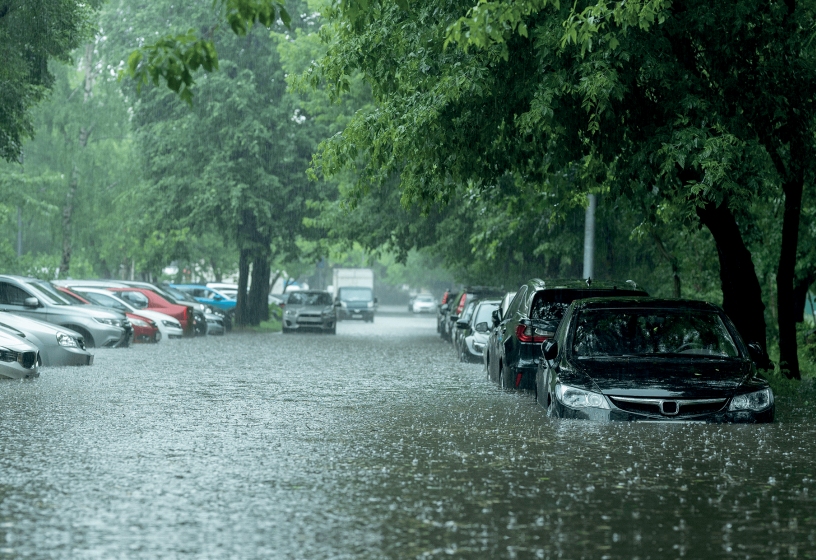"Climate Change is Certainly the matrix for all Other Risks"

Olivier Desbiey is in charge of foresight for the AXA Group. His day-to-day business consists of analysing in-depth trends. Those that are shaping tomorrow's society. In other words, Olivier explores and anticipates possible futures to be prepared for them. Among the significant changes to be expected, climate change. What are the greatest challenges for society and particularly for the insurance sector faced with this new era? This is what we endeavoured to explore together in this interview.
INTERVIEW
Sustainability MAG: Why is foresight a discipline that is increasingly taken into account at AXA?
Olivier Desbiey: Its purpose is to identify and anticipate the challenges we will face in the future to prepare for them. We want to understand the issues linked to socio-economic, environmental, and health-related challenges. They present risks and opportunities for society and the insurance sector. Therefore, we are studying these questions, with a particular interest in the consequences for AXA, as an insurer, an employer, and a responsible and committed player. This work takes the form of research, notably through an annual foresight report. Another part of AXA's foresight mission is to support our internal teams in their reflections on emerging subjects. This is done by providing creativity, for example, through workshops where we mix data, science, and design fiction.
On climate change, for example, what complementary insights do you bring to the forecast scenarios provided by the IPCC?
On this subject, the hypotheses resulting from the IPCC's work are obviously a starting point that guides our work. The interesting point is precisely the complementarity between the forecasting approach and foresight. The first one envisages the future as a logical continuation of the present. The second can also consist of imagining ruptures such as black swans that can redraw the balance and lead to other trajectories.
Another form of complementarity we are trying to include in our work is bringing these global warming scenarios to life. It is about imagining and telling the story of what the world might look like in 2040 by drawing attention to other aspects, particularly economic, social, and even geopolitical outcomes. In our latest prospective exploration earlier this year, we looked at climate issues and projected what the 2036 COP42 agreement in Dubai (relocated to Tanzania) would look like. This is a completely speculative scenario. We cannot predict the future, but it is based on credible assumptions. Despite the media coverage of COP26 in Glasgow, this topic can sometimes seem abstract. Especially if it is reduced to technical hypotheses of global warming only. Illustrating it with imaginary images, which can sometimes take the form of science fiction, can help make the issues more concrete and easier to grasp for the general public.
What is special about climate risk compared to other risks usually covered by the insurance sector?
In terms of its characteristics, compared to other major emerging threats, climate change is certainly the matrix for all other risks. New epidemics could emerge with the effects of global warming and the associated disruption of ecosystems. A combination of increased urbanisation and the relocation of certain activities due to rising sea levels, for example, may bring humans closer to species and viruses to which they have not been exposed in the past. Similarly, the consequences of natural disasters such as floods can impact on critical infrastructure, for example, by damaging IT facilities. This could weaken IT security systems and lead to cyber risk.
Another example is the coastal areas. They are often densely populated and will be primarily affected by one of the manifestations of climate change, namely rising sea levels. Climate-induced migration can be expected in the future. This could ultimately have geopolitical consequences.
This growing interconnection and risks entanglement are at the heart of AXA's Future Risk Report. It ranks emerging risks according to a panel of more than 3,500 experts worldwide. Since 2018, three major risks have returned to the podium: climate change, cyber-security risks, geopolitical instability. Since 2020, pandemic risk has obviously been added. This ranking varies according to the different regions of the world. In 2021, cyber risk is leading in the USA. Pandemic risk is at the top of the list in Asia and Africa, while climate change remains the primary concern in Europe.
And finally, to get back to climate risk, the last characteristic that interests me most, particularly as a foresight specialist, is that it represents both a present and a future danger. The floods that we experienced this summer, particularly in Luxembourg, are a bit like the future knocking at our door today as a sign of what the future could hold.
In any case, it demonstrates that these significant risks are not just theoretical and that it is essential to anticipate and understand them. This is what AXA is doing through the Future Risks Report, the scientific work we support through the AXA Research Fund, and our foresight approach.
To what extent is the insurance sector affected by these climate risks today?
Based on our French entity's data, we can see that the cost of climate-related claims doubles every 20 years. For AXA France, the cost has risen from 1.2 billion euros per year in the eighties to 3.2 billion in 2020. It could exceed six billion by 2050.
While fires are still the main source of damage today, natural events are taking on greater weight and are expected to exceed them in the future.
More prospectively, we published a report in early 2020 on mental health and well-being. A lesser-known angle on the health effects of climate change is that it can cause new forms of anxiety. The concept of solastalgia, referring to the anticipation that a valued natural environment may be threatened and that we may no longer have access to it one day, captures this new form of eco-anxiety. A recent study to be published in the scientific journal ''The Lancet Planetary Health'' indicates that this feeling is particularly strong among the younger generation. Carried out on 10,000 young people aged 16 to 25 in ten countries, it shows that 59% of them say they are worried or very worried about climate change. 45% even feel that climate anxiety negatively affects their daily lives. This is an extremely powerful feeling, and we see that mental health issues are still not very well known today. However, the current crisis has had a magnifying effect on this issue, particularly during the spring 2020 confinements, confirming that this will be one of the major health concerns of the next decade for society and insurers.
In this context, how can reasonable prices be maintained for policyholders?
Structurally, the response to the major challenges we mentioned, cyber, climate change, and pandemics, will require the development of public-private partnerships to secure mutualisation and continue to make these risks insurable.
What responses are you already providing to deal with the climate challenge?
AXA is working on several axes. Prevention is a crucial element of the model. It will play a fundamental role in building society's resilience and will make it possible to offer insurance at acceptable prices. This is the first element of the response: better sharing our expertise on risks. The second element is to better value solutions that are based on nature. Thirdly, it seems rather obvious, but we need to be exemplary in terms of the environmental impact of our activities. This means training our employees, which we do for all. Lastly, I would like to mention the deployment of innovative solutions such as parametric insurance via our subsidiary AXA Climate. Parametric insurance is an innovative product, on the one hand, in the way the relationship with the client is managed, since compensation is extremely fast, and above all because the claims are observed by third-party sources. This may be weather data that records a period of frost in a given area, satellite images, or other ground sensors that allow the client to be compensated automatically, depending on the risk. This is very relevant in the agricultural sector to ensure land and act upstream on prevention.
So you are also relying more and more on technology in the area of prevention?
Yes. And it's really in parametric insurance that the solutions are the most sophisticated. But technologies can be used in other areas. Take the example of agriculture. Thanks to models and accumulated data on soil characteristics, AXA can make recommendations on the specific species to cultivate and thus assist in the reorientation of activity. The aim here is to be more preventive, i.e., to alert clients to a climatic event that could affect them and promulgate advice on protecting themselves. It is also AXA's ambition as an insurer to move from being a payer to being a true partner of our clients.
Does your traditional product offering for individuals also reflect this role of supporting and encouraging changes in practices?
Absolutely. For example, certain offers developed by AXA France aim to encourage responsible behaviour. Typically, this can be done through differentiated rates or guarantees for electric vehicles. Also, photovoltaic equipment on a house will be particularly well covered in the event of a claim. In case of damage to your car, the use of second-hand parts will be preferred whenever possible. More generally, many components of our offers aim to encourage and support the energy renovation sector.
AXA is a member of several alliances and even chairs one of them, the Net-Zero Alliance. What ambition does this reflect?
AXA is acting as a driving force and pioneer because one cannot act alone when faced with global challenges. This sometimes involves public-private partnerships and, in other cases, coalitions of players such as the TCFD, TNFD, or Net-Zero Alliance task forces. The strength of large international groups lies precisely in their ability to bring on board a whole ecosystem of players and scale up so that their commitments impact the real economy.
In this sense, AXA is moving forward on its two feet as an insurer and as an investor. On the one hand, this may mean excluding certain activities, as in the energy sector, where we have recently announced a strengthening of our actions vis-à-vis the oil and gas sectors. On the other hand, the insurance industry can also support virtuous activities by investing in green and low-carbon energy, for example.
Is the insurance sector at a turning point in its existence? What is the forecaster's view of the future of his own industry?
The current crisis has demonstrated the central role of the insurance sector in society. Most of my colleagues in foresight describe a future world characterised by repeated crises with a higher degree of complexity and uncertainty. In such a context, one can expect that the protection needs of individuals or companies will evolve in the future. With its expertise in moving from uncertainty to risk, we may be on the threshold of the golden age of the insurance industry.

Desbiey Olivier
In charge of foresight for the AXA Group


